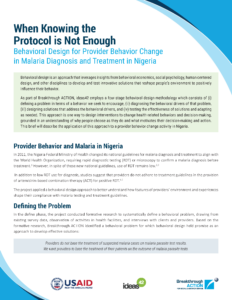In 2011, the Nigeria Federal Ministry of Health changed its national guidelines for malaria diagnosis and treatment to align with the World Health Organization, requiring rapid diagnostic testing (RDT) or microscopy to confirm a malaria diagnosis before treatment. However, in spite of these new national guidelines, the use of RDT remains low. In addition to low RDT use for diagnosis, studies suggest that providers do not adhere to treatment guidelines in the provision of artemisinin-based combination therapy for positive RDT. Breakthrough ACTION applied a behavioral design approach to better understand how features of providers’ environment and experiences shape their compliance with malaria testing and treatment guidelines.



